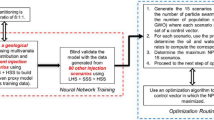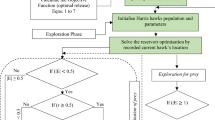Abstract
The optimization of water alternating gas injection (WAG) process is a complex problem, which requires a significant number of numerical simulations that are time-consuming. Therefore, developing a fast and accurate replacing method becomes a necessity. Proxy models that are light mathematical models have a high ability to identify very complex and non-straightforward problems such as the answers of numerical simulators in brief deadlines. Different static proxy models have been used to date, where a predefined model is employed to approximate the outputs of numerical simulators such as field oil production total (FOPT) or net present value, at a given time and not as functions of time. This study demonstrates the application of time-dependent multi Artificial Neural Networks as a dynamic proxy to the optimization of a WAG process in a synthetic field. Latin hypercube design is used to select the database employed in the training phase. By coupling the established proxy with genetic algorithm (GA) and ant colony optimization (ACO), the optimum WAG parameters, namely gas and water injection rates, gas and water injection half-cycle, WAG ratio and slug size, which maximize FOPT subject to some time-depending constraints, are investigated. The problem is formulated as a nonlinear optimization problem with bound and nonlinear constraints. The results show that the established proxy is found to be robust and an efficient alternative for mimicking the numerical simulator performances in the optimization of the WAG. Both GA and ACO are strongly shown to be highly effective in the combinatorial optimization of the WAG process.
Similar content being viewed by others
Abbreviations
- AAPRD:
-
Average absolute percent relative deviation, %
- ANN:
-
Artificial neural network
- GA:
-
Genetic algorithm
- ACO:
-
Ant colony optimization
- BP:
-
Back propagation
- LHD:
-
Latin hypercube design
- FOPT:
-
Field oil production total, \(\hbox {sm}^{3}\)
- FOPR:
-
Field oil production, \(\hbox {sm}^{3}/\hbox {d}\)
- FGPT:
-
Field gas production total, \(\hbox {sm}^{3}\)
- FGPR:
-
Field gas production, \(\hbox {sm}^{3}/\hbox {d}\)
- FWPT:
-
Field water production total, \(\hbox {sm}^{3}\)
- FWPR:
-
Field water production, \(\hbox {sm}^{3}/\hbox {d}\)
- FGIR:
-
Field gas injection rate, \(\hbox {sm}^{3}/\hbox {d}\)
- FWIR:
-
Field water injection rate, \(\hbox {sm}^{3}/\hbox {d}\)
References
Tillerson, R.W.: Meeting Global Energy Supply And Demand Challenges (2008)
Christensen, J.R.; Stenby, E.H.; Skauge, A.: Review of WAG field experience. SPE Reserv. Eval. Eng. 4, 97–106 (2001)
Larry, W.L.; Russell Johns, B.R.; G.P.: Enhanced Oil Recovery. Henry L. Doherty Memorial Fund of AIME, Society of Petroleum Engineers (1996)
Algharaib, M.K.; Gharbi, R.B.; Malallah, A.; Al-Ghanim, W.: Parametric investigations of a modified SWAG injection technique. In: SPE Middle East Oil and Gas Show and Conference, Society of Petroleum Engineers (2007)
Christensen, J.R.; Stenby, E.H.; Skauge, A.: Review of WAG field experience. In: International Petroleum Conference and Exhibition of Mexico, Society of Petroleum Engineers (1998)
Al-Mamari, F.; Al-Shuraiqi, H.; Al-Wahaibi, Y.M.: Numerical simulation and experimental studies of oil recovery via first-contact miscible water alternating gas injection within shaley porous media. In: SPE/EAGE Reservoir Characterization and Simulation Conference, Society of Petroleum Engineers (2007)
Skauge, A.; Dale, E.I.: Progress in immiscible WAG modelling. In: SPE/EAGE Reservoir Characterization and Simulation Conference, Society of Petroleum Engineers (2007)
Gharbi, R.B.C.; Mansoori, G.A.: An introduction to artificial intelligence applications in petroleum exploration and production. J. Pet. Sci. Eng. 49, 93–96 (2005)
Sayyafzadeh, M.: A self-adaptive surrogate-assisted evolutionary algorithm for well placement optimization problems. In: SPE/IATMI Asia Pacific Oil and Gas Conference and Exhibition, Society of Petroleum Engineers (2015)
Sayyafzadeh, M.: History matching by online metamodeling. In: SPE Reservoir Characterisation and Simulation Conference and Exhibition, Society of Petroleum Engineers (2015)
Shahkarami, A.; Mohaghegh, S.D.; Gholami, V.; Haghighat, S.A.: Artificial intelligence (AI) assisted history matching. In: SPE Western North American and Rocky Mountain Joint Meeting, Society of Petroleum Engineers (2014)
Mohaghegh, S.D.: Quantifying uncertainties associated with reservoir simulation studies using a surrogate reservoir model. In: SPE Annual Technical Conference and Exhibition, Society of Petroleum Engineers (2006)
Mohaghegh, S.D.: Artificial intelligence and data mining: enabling technology for smart fields. W. Ahead. 5, 14–19 (2009)
Mohaghegh, S.D.: Reservoir simulation and modeling based on pattern recognition. In: SPE Digital Energy Conference and Exhibition, Society of Petroleum Engineers (2011)
Amini, S.; Mohaghegh, S.D.; Gaskari, R.; Bromhal, G.: Uncertainty analysis of a CO\(_{2}\) sequestration project using surrogate reservoir modeling technique. In: SPE Western Regional Meeting, Society of Petroleum Engineers (2012)
Panjalizadeh, H.; Alizadeh, N.; Mashhadi, H.: A workflow for risk analysis and optimization of steam flooding scenario using static and dynamic proxy models. J. Pet. Sci. Eng. 121, 78–86 (2014)
Valadi, J.; Siarry, P.: Applications of Metaheuristics in Process Engineering. Springer International Publishing, Cham (2014)
Gomez, S.; Fuentes-Cruz, G.; Camacho Velazquez, R.; Vasquez-Cruz, M.A.; Otero, J.; Mesejo, A.; Del Castillo, N.: Application of an evolutionary algorithm in well test characterization of naturally fractured vuggy reservoirs. In: International Oil Conference and Exhibition in Mexico, Society of Petroleum Engineers (2006)
Hajizadeh, Y.; Christie, M.; Demyanov, V.: Ant colony optimization for history matching and uncertainty quantification of reservoir models. J. Pet. Sci. Eng. 77, 78–92 (2011)
Onwunalu, J.E.; Durlofsky, L.J.: Application of a particle swarm optimization algorithm for determining optimum well location and type. Comput. Geosci. 14, 183–198 (2010)
Nghiem, L.; Mirzabozorg, A.; Yang, C.; Chen, Z.: Differential evolution for assisted history matching process: SAGD Case Study. In: SPE Heavy Oil Conference-Canada, Society of Petroleum Engineers (2013)
Popa, A.S.; Sivakumar, K.; Cassidy, S.D.: Associative data modeling and ant colony optimizaton approach for waterflood analysis. In: SPE Western Regional Meeting, Society of Petroleum Engineers (2012)
Kirsch, U.: Efficient reanalysis for topological optimization. Struct. Optim. 6, 143–150 (1993)
Holland, J.H.: In: Adaptation in Natural and Artificial Systems. University of Michigan Press, Ann Arbor (1975)
Sicanandam, S.N.; Deepa, S.N.: Introduction to Genetic Algorithms. Springer, Berlin (2007)
Dorigo, M.; Gambardella, L.M.: Ant colony system: a cooperative learning approach to the traveling salesman problem. IEEE Trans. Evol. Comput. 1, 53–66 (1997)
Dorigo, M.; Maniezzo, V.; Colorni, A.: Ant system: optimization by a colony of cooperating agents. IEEE Trans. Syst. Man Cybern. Part B 26, 29–41 (1996)
Deb, K.: An efficient constraint handling method for genetic algorithms. Comput. Methods Appl. Mech. Eng. 186, 311–338 (2000)
Noraini, M.; Geraghty, J.: Genetic algorithm performance with different selection strategies in solving TSP. World Congr. Eng. II, 4–9 (2011)
ECLIPSE Industry Reference Reservoir Simulator (2012)
Forrester, A.I.J.; Sóbester, A.; Keane, A.J.: Engineering Design via Surrogate Modelling: A practical Guide. Wiley, London (2008)
MathWork (2016)
Eiben, A.E.; Hinterding, R.; Michalewicz, Z.: Parameter control in evolutionary algorithms. IEEE Trans. Evol. Comput. 3, 124–141 (1999)
Jamil, M.; Yang, X.S.: A literature survey of benchmark functions for global optimisation problems. Int. J. Math. Model. Numer. Optim. 4, 150 (2013)
Koziel, S.; computation, Z.M.-E.: Undefined: Evolutionary Algorithms, Homomorphous Mappings, and Constrained Parameter Optimization. MIT Press, Cambridge (1999)
Author information
Authors and Affiliations
Corresponding author
Rights and permissions
About this article
Cite this article
Nait Amar, M., Zeraibi, N. & Redouane, K. Optimization of WAG Process Using Dynamic Proxy, Genetic Algorithm and Ant Colony Optimization. Arab J Sci Eng 43, 6399–6412 (2018). https://doi.org/10.1007/s13369-018-3173-7
Received:
Accepted:
Published:
Issue Date:
DOI: https://doi.org/10.1007/s13369-018-3173-7




